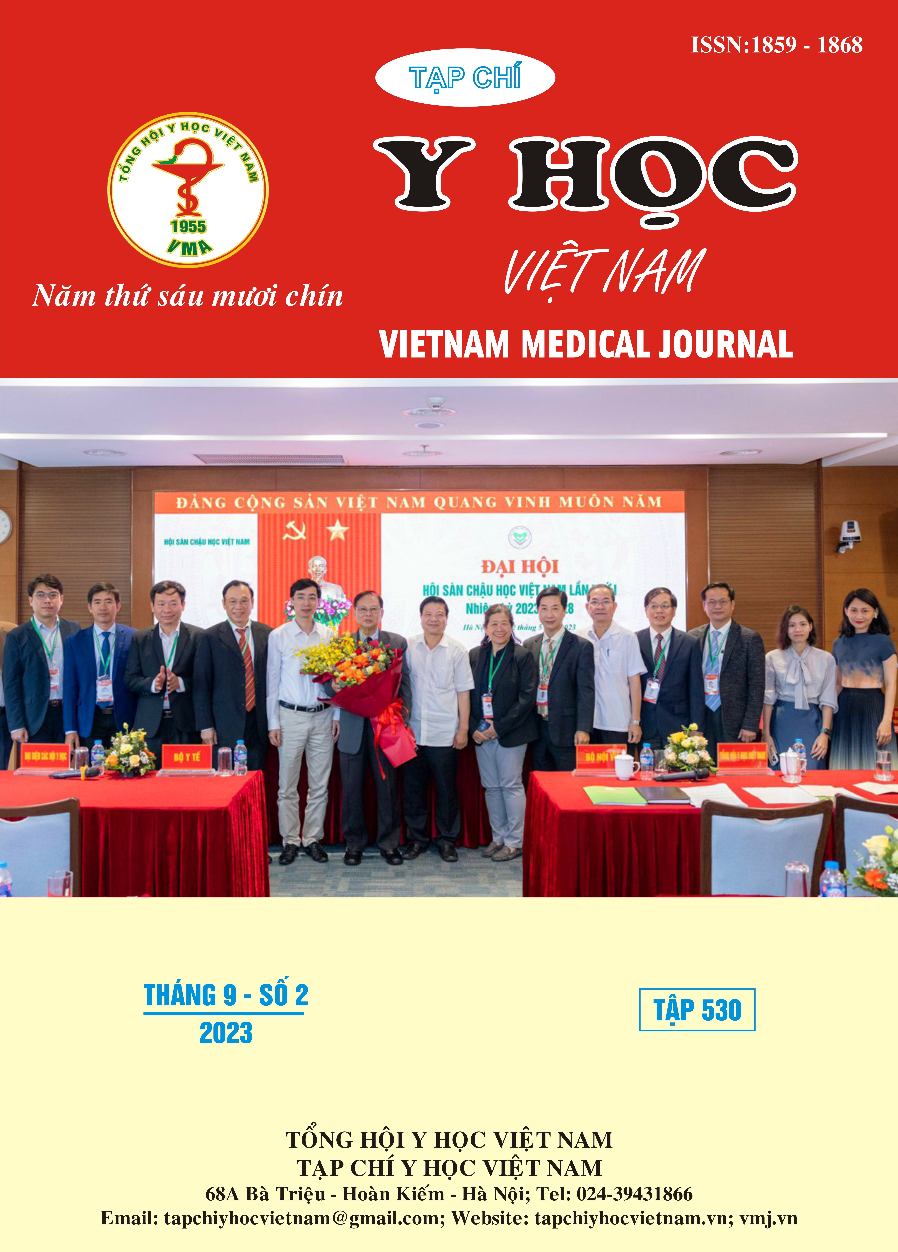VALUE OF ULTRASOUND-GUIDED CORE BIOPSY OF BI-RADS 4 AND 5 BREAST LESIONS
Main Article Content
Abstract
Objectives: To describe the imaging features of breast lesions suggestive of malignancy according to American college of Radiology (ACR) terms during ultrasound guided core needle biopsy (CNB), and evaluate the successes as well complications of CNB. Methods: A retrospective study cases series study. All 186 female patients who went to the oncology hospital for examination and diagnosed with BIRADS 4,5 breast lesion on ultrasound assigned to have needle core biopsy (NCB) and had pathological results from May 2020 to May 2021. Results: mean age of 52,3 years old, group of 40-49 years old account for the highest proportion (30%). The average age of the study sample was 52.3 years old; the age of the disease was highest in the group of 40 - 49 years old (accounting for 30%). 38% of patients had time to detection between 1 and 6 months. The distribution of right and left tumors is almost the same: 46.24% on left side and 43.55% on right size. Most tumors were >20-40mm in size at the time of detection, accounting for 40.86%. The rate of malignancy in disease groups was: 4A (4.3%), 4B (18.3%), 4C (33.3%), 5 (27.5%). The characteristic on ultrasound of malignant tumors is: irregular shape (94.84%), not parallel orientation (98.06%), micro-lobulated margin (52.9%), hypoechoic (85,16%), posterior acoustic features with combined pattern (65.81%), intra-tumor microcalcification (45.81%). There were significant difference imaging features between the malignant and benign lesion. Most patients received 5 cores of ST (59%). There were 3 patients with mild complications (2 cases of bleeding and 1 case of hematoma). Pathological results showed that carcinoma accounted for the highest rate (78.49%). Conclusion: Ultrasound-guided CNB help diagnose breast cancer with low complication rate, helping clinicians to plan appropriate treatment for each patient.
Article Details
Keywords
core needle biopsy, ultrasound, breast lesion, BIRADS 4,5.
References
2. Elverici E, Barça AN, Aktaş H, Özsoy A, Zengin B, Çavuşoğlu M, et al. Nonpalpable BI-RADS 4 breast lesions: sonographic findings and pathology correlation. Diagnostic and Interventional Radiology. 2015;21(3):189.
3. Hoagland LF, Hitt RA. Techniques for ultrasound-guided, percutaneous core-needle breast biopsy. Appl Radiol. 2013;42:14-9.
4. Hoàng Đức Quyền. Giá trị tế bào học qua thủ thuật chọc hút tế bào bằng kim nhỏ dưới hướng dẫn siêu âm trong chẩn đoán ung thư vú. Tạp chí ung thư học Việt Nam. 2011:461-7.
5. Kim E-K, Ko KH, Oh KK, Kwak JY, You JK, Kim MJ, et al. Clinical application of the BI-RADS final assessment to breast sonography in conjunction with mammography. American journal of roentgenology. 2008;190(5):1209-15.
6. Mông Thị Hồng Yến. Đối chiếu tổn thương vú không sờ thấy xếp BI-RADS 4 trên siêu âm với mô bệnh học. Luận văn tốt nghiệp bác sĩ nội trú: Đại học YD TPHCM; 2019.
7. Nguyễn Thị Hồng Ánh. Giá trị của FNA trên siêu âm bệnh nhân nữ dưới 35 tuổi có tổn thương vú BIRADS 4,5. Luận văn chuyên khoa cấp 2, Đại học Y Khoa Phạm Ngọc Thạch. 2020.
8. Okoli C, Ebubedike U, Anyanwu S, Chianakwana G, Emegoakor C, Ukah C, et al. Ultrasound-Guided Core Biopsy of Breast Lesions in a Resource Limited Setting: Initial Experience of a Multidisciplinary Team. European Journal of Breast Health. 2020;16(3):171.
9. Paola Pagni FS, Simona Barberi, Giuliana Caprio, Carlo Paglicci. Use of Core Needle Biopsy rather than Fine-Needle Aspiration Cytology in the Diagnostic Approach of Breast Cancer. Case Rep Oncol. 2014;7:452-58.
10. Phạm Tuấn Mạnh. Đánh giá sự tương hợp của sinh thiết lõi kim và giải phẫu bệnh trong chẩn đoán carinome vú. Luận văn thạc sĩ y học, Đại học Y Dược thành phố Hồ Chí Minh. 2016.


